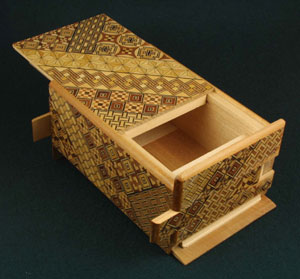
Larger Photograph (111.9K)

Larger Photograph (101.5K)
| Designer | : | Unknown |
| Craftsman | : | Unknown |
| Category | : | Take-Apart |
| Material | : | Various |
|
Traditional Japanese Trick boxes have been imported into the U. S. since the 1920's. In Japan, they are known as Himitsu-Bako (Personal Secret Box). They were first made more than 100 years ago in the Hakone region of Japan as souveniers for people visiting the hot springs in the area.
To open them, one or more sliding pieces on each end are moved, allowing the end to slide down one step and the top to slide one step towards the side. Then the piece on the other end is slid, allowing that end to slide up and the bottom to slide in a direction opposite the top. This can be repeated many times in the more complicated boxes before the top finally slides all the way open. The sliding pieces are hidden in the patterns on the box. The veneer used to cover the boxes is called yosegi zaiku marquetry. The veneer for a typical box like the one in the photographs is made by gluing up sticks of different colored woods. Then the glued sticks are cut into smaller chunks and the chunks are glued together. This is repeated until a "plate" about 50mm thick called a tanegi is created with the desired complete pattern. The tanegi is then shaved with a special plane into thin sheets called zuku. The curled zuku sheet is then ironed into a flat sheet of veneer for application onto the boxes. All of these operations are traditionally done by hand. The veneer is used for many products other than the trick boxes. Less common is veneer with Japanese scenes made using traditional inlay techniques. The trick opening boxes were first made by Ryugoro Okawa, a master craftsman who lived in the Hakone area at the end of the nineteenth century. Yoshio Okiyama, who was influenced by Okawa, makes boxes requiring as many as 122 moves to open. The son of one of Okawa's apprentices is Yoshiyuki Ninomiya, Akio Kamei's teacher, who is well known for his beautiful yosegi trick boxes and his extraordinary interlocking puzzles. One of his most famous is a 106-piece, five story pagoda. | ||